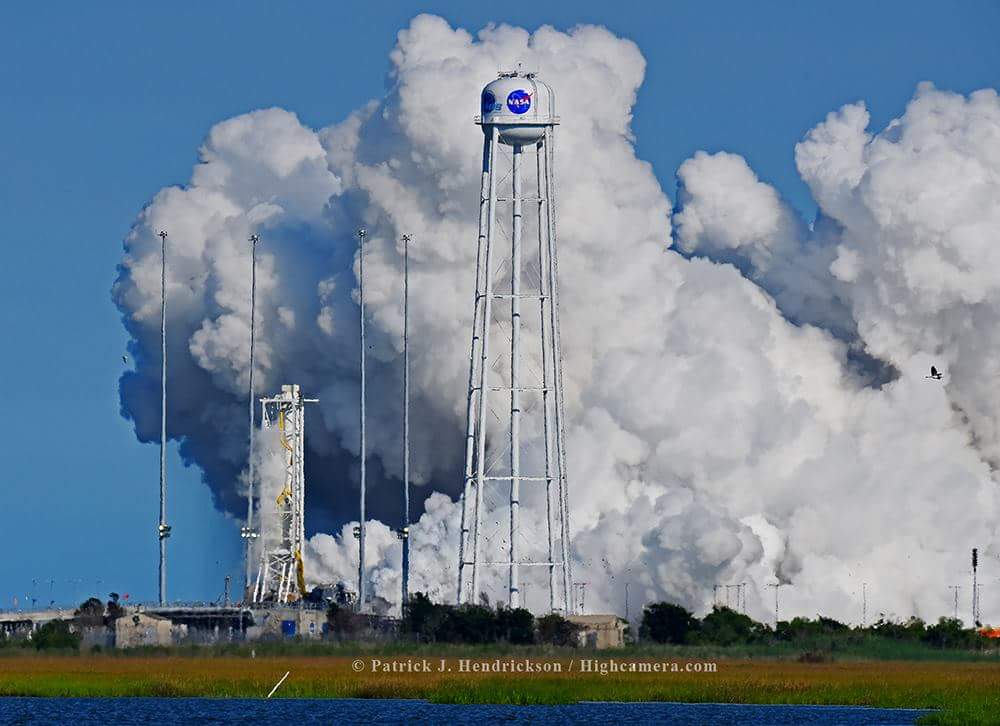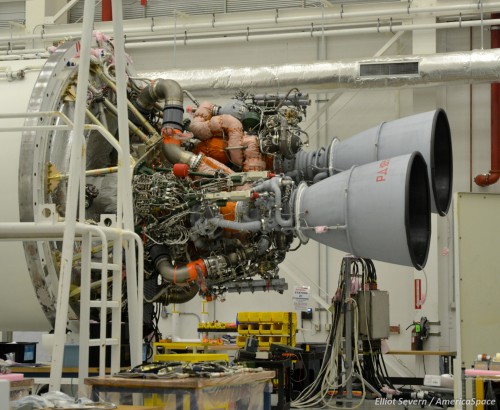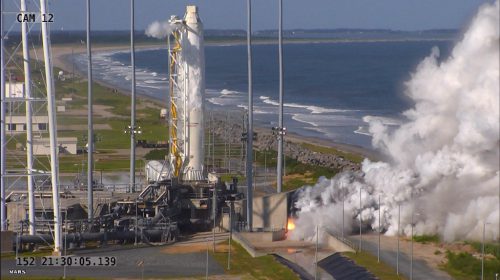
Nineteen months after the catastrophic loss of its ORB-3 mission—laden with a Cygnus cargo spacecraft, headed for the International Space Station (ISS)—Orbital ATK yesterday (Tuesday, 31 May) completed a full-power hot-fire test of the upgraded first-stage of its Antares 230 booster. Utilizing a pair of Russian-built RD-181 engines, fed by liquid oxygen and a highly refined form of rocket-grade kerosene, known as “RP-1,” the first stage was installed on Pad 0A at Virginia Space’s Mid-Atlantic Regional Spaceport (MARS) on Wallops Island, Va., for the 30-second test. This was the same pad used for the five prior Antares missions, including the short-lived ORB-3 on 28 October 2014. The maiden voyage of the Antares 230 is currently scheduled for early July 2016, delivering the OA-5 Cygnus toward the space station.
Antares’ first stage rumbled to life at 5:30 p.m. EDT and progressed through a steady series of thrust milestones, before the Main Engine Cutoff (MECO) command was called. “Early indications show the upgraded propulsion system, core stage and launch complex all worked together as planned,” said Mike Pinkston, Orbital ATK’s general manager and vice president for the Antares Program. “Congratulations to the combined NASA, Orbital ATK and Virginia Space team on what appears to be a successful test.”

Yesterday’s sight bore a close physical resemblance to the first stage of the Antares 100-class vehicles which rose from Pad 0A on five occasions between April 2013 and October 2014. And so it should, for the dimensions and size are broadly the same. In fact, the only difference is that the Aerojet Rocketdyne-furnished AJ-26 first-stage engine suite has been replaced by the higher-performing RD-181 on the Antares 230. According to Spaceflight101, the first stage draws on the heritage of the Soviet-era Zenit booster and was designed by the Yuzhnoye State Design Office and manufactured by Yuzhmash State Enterprise, both based in Ukraine’s fourth-largest city, Dnipropetrovsk. As well as providing the structural support for Antares, the first stage houses propellant bays for liquid oxygen and RP-1 tankage, together with associated plumbing, pressurization systems, instrumentation, the engines themselves, and the Flight Termination System (FTS).
The RD-181—built by Moscow-based NPO Energomash— was intended as a replacement for the AJ-26 at the time of the ORB-3 failure in October 2014. In fact, Orbital Sciences Corp. intended to continue using the AJ-26 aboard its Antares 130 vehicles until the upgraded Antares 230 became available in 2016. As outlined previously by AmericaSpace, 36 Russian-built NK-33 engines were purchased in the mid-1990s and extensively modernized by Aerojet Rocketdyne and Orbital under the new name of “AJ-26.” Despite age-related cracking and fuel leaks on the test stand, the old engines performed well on four Antares launches, before suffering an explosion in May 2014 at NASA’s Stennis Space Center (SSC) in Hancock County, Miss. The loss of ORB-3, and the realization that an AJ-26 turbopump failure was to blame, prompted Orbital to push ahead for “an early introduction of its previously selected Antares propulsion system upgrade in 2016.”
Bridging the gap between the resumption of Antares missions and its contract with NASA to stage ongoing cargo flights to the ISS, Orbital contracted with United Launch Alliance (ULA) in November 2014 to deliver a pair of Cygnuses via the Atlas V booster. These missions, OA-4 and OA-6, flew successfully in December 2015 and March 2016.
In the months after the ORB-3 accident, assessments of damage to the MARS site were undertaken and repairs and reconstruction were completed on 30 September 2015. Performance tests of the new systems concluded in early November. Original plans called for an entire Antares vehicle—earmarked for the OA-5 Cygnus mission—to be used for the hot-fire test. “Instead, a separate core stage will be used so that processing of the OA-5 vehicle can proceed in parallel with the test,” wrote AmericaSpace’s Elliot Severn last December. “The test stage will later be refurbished and used to launch the OA-7 mission.” In readiness for the test, the core stage was transferred to Pad 0A from the nearby Horizontal Integration Facility (HIF) on 12 May 2016.

Yesterday’s test appears to have proceeded without incident. Within five seconds after T-0, the RD-181 engines attained 100 percent of rated performance, which peaks at 830,000 pounds (376,400 kg). This represents an approximately 12.5-percent enhancement in propulsive yield over the 734,000-pound (332,900-kg) impulse of the AJ-26 engines. During their burn, the engines performed beautifully, throttling back to 75 percent of rated performance by 15 seconds, then back still further to 55 percent at the 25-second mark, before responding crisply to shutdown commands at 30 seconds. “Congratulations Test Team, on what appears to be a nominal hot-fire test,” came the call after MECO.
The test satisfactorily verified the functionality of the 90.5-foot-long (27.6-meter) first stage, including its engines, modified core, avionics, and Thrust Vector Control (TVC), as well as the fueling systems at Pad 0A. “During the test, a number of operational milestones were met including full propellant loading sequence, launch countdown and engine ignition and shutdown commands,” Orbital ATK noted, “as well as multiple throttle settings, including full engine power.” Additionally, the launch pad’s tanking and water-deluge systems were successfully tested.
Next steps for the vehicle are for the purging and cleaning of all residual propellants, ahead of return to the HIF for full reconditioning, ahead of its future role on OA-7. According to Novosti Kosmonavtiki, the latter is scheduled for launch in late December 2016. Before then, the maiden launch of the Antares 230—targeted for 6 July from Pad 0A at MARS—will deliver the OA-5 Cygnus to the space station. Repairs to the Pad 0A complex itself, outlined recently by AmericaSpace’s Mike Killian, have seen a fresh layer of ablative material inside the flame trench. “The hot-fire usually causes more wear and tear, because it sits here and dwells for more than 30 seconds,” explained Dale Nash, director of the Virginia Commercial Space Flight Authority. “On a normal launch, it’s no more than a few seconds before it goes away.” The repairs should sustain Pad 0A not only for yesterday’s hot-fire test, but also for as many as five Antares launches in quick succession.

From the standpoint of its commitment to NASA, eight Cygnus missions were contracted, back in December 2008, under the initial $1.9 billion Commercial Resupply Services (CRS) contract.
With the increased lifting capabilities of the Antares 230 and ULA’s Atlas V—together with last year’s introduction of the higher-payload-capacity “Enhanced Cygnus”—Orbital ATK aims to complete its initial CRS commitment with NASA by the seventh Cygnus mission, rather than the eighth. Last August, Space News reported that two additional Cygnus flights had also been contracted. Together with the already-baselined eighth mission, these formed part of an “Extension” program (designated “8E” through “10E”) to bridge the gap between the end of the original CRS contract and a follow-on CRS2 contract. It is expected that OA-8E, 9E, and 10E will fly in the 2017-2018 period. More recently, in January 2016, Orbital ATK had won a share of the CRS2 contract for six follow-on missions, beyond OA-10E, in the 2019-2024 timeframe.
To date, including the OA-6 vehicle currently on-orbit, Cygnus missions have delivered 24,000 pounds (10,900 kg) of equipment and supplies to no fewer than 11 station crews, from Expedition 37 in September 2013 to the current Expedition 47. “Under the CRS contract with NASA, Orbital ATK will deliver approximately 62,000 pounds (28,000 kg) of cargo to the ISS over 11 missions through 2018,” the company reported.
Want to keep up-to-date with all things space? Be sure to “Like” AmericaSpace on Facebook and follow us on Twitter: @AmericaSpace






Thank you Ben Evans for this nifty article!
I do like the Antares 230!
And I fully expect that future Antares launchers will support humans and robots in tapping the Moon’s resources to reduce the risks and costs of developing all of Cislunar Space!
Launcher flexibility for the Enhanced Cygnus is a useful backup option to help ensure that needed supplies reach the International Space Station in a timely manner.
“Orbital ATK intends to keep open the option of launching Cygnuses on Atlas V rockets in the future. It recently won a new set of cargo launches to ISS under the second Commercial Resupply Services (CRS) contract, CRS2. Orbital ATK Space Systems President Frank Culbertson said in March that the ability to launch on either rocket offers flexibility so both were offered in the contract.”
From: ‘Orbital ATK Completes Antares Hot Fire Test’ Marcia S. Smith May 31,2016
At: http://www.spacepolicyonline.com/news/orbital-atk-conducts-antares-hot-fire-test